NCERT Solutions for Class 10 Maths Chapter 14 Statistics
Statistics NCERT Solutions – Class 10 Maths
Exercise 14.1 : Solutions of Questions on Page Number : 270
Q1 : A survey was conducted by a group of students as a part of their environment awareness programme, in which they collected the following data regarding the number of plants in 20 houses in a locality. Find the mean number of plants per house.
| Number of plants |
0– 2 |
2– 4 |
4 – 6 |
6 – 8 |
8 – 10 |
10 – 12 |
12 – 14 |
| Number of houses |
1 |
2 |
1 |
5 |
6 |
2 |
3 |
Which method did you use for finding the mean, and why?
Answer :
To find the class mark (xi) for each interval, the following relation is used.
Class mark (xi) =![]()
xi and fixi can be calculated as follows.
| Number of Plants | Number of house (fi) |
xi | fixi |
| 0-2 | 1 | 1 | 1×1=1 |
| 2-4 | 2 | 3 | 2×3=6 |
| 4-6 | 1 | 5 | 1×5=5 |
| 6-8 | 5 | 7 | 5×7=35 |
| 8-10 | 6 | 9 | 6×9=54 |
| 10-12 | 2 | 11 | 2×11=22 |
| 12-14 | 3 | 13 | 3×13=39 |
| Total | 20 | 162 |
 From the table, it can be observed that
From the table, it can be observed that
Mean,
![]()
Therefore, mean number of plants per house is 8.1.
Here, direct method has been used as the values of class marks (xi) and fi are small.
Q2 : Consider the following distribution of daily wages of 50 worker of a factory.
| Daily wages (in Rs) |
100- 120 |
120- 140 |
140 – 1 60 |
160 – 180 |
180 – 200 |
| Number of workers |
12 |
14 |
8 |
6 |
10 |
Find the mean daily wages of the workers of the factory by using an appropriate method.
Answer :
To find the class mark for each interval, the following relation is used.
![]()
Class size (h) of this data = 20
Taking 150 as assured mean (a), di, ui, and fiui can be calculated as follows.
|
Daily wages (in Rs) |
Number of workers (fi) |
xi |
di =xi– 150 |
|
fiui |
|
100 |
12 |
110 |
– 40 |
– 2 |
– 24 |
|
120 |
14 |
130 |
– 20 |
– 1 |
– 14 |
|
140 – 160 |
8 |
150 |
0 |
0 |
0 |
|
160 – 180 |
6 |
170 |
20 |
1 |
6 |
|
180 – 200 |
10 |
190 |
40 |
2 |
20 |
|
Total |
50 |
– 12 |
From the table, it can be observed that


Therefore, the mean daily wage of the workers of the factory is Rs 145.20.
Q3 : The following distribution shows the daily pocket allowance of children of a locality. The mean pocket allowance is Rs.18. Find the missing frequency f.
| Daily pocket allowance (in Rs) |
11-13 |
13-15 |
15-17 |
17-19 |
19-21 |
21-23 |
23-25 |
| Number of workers |
7 |
6 |
9 |
13 |
f |
5 |
4 |
Answer :
To find the class mark (xi) for each interval, the following relation is used.
![]()
Given that, mean pocket allowance,![]()
Taking 18 as assured mean (a), di and fidi are calculated as follows.
|
Daily pocket allowance (in Rs) |
Number of children fi |
Class mark |
di =xi– 18 |
fidi |
|
11- 13 |
7 |
12 |
– 6 |
– 42 |
|
13 – 15 |
6 |
14 |
– 4 |
– 24 |
|
15 – 17 |
9 |
16 |
– 2 |
– 18 |
|
17 – 19 |
13 |
18 |
0 |
0 |
|
19 – 21 |
f |
20 |
2 |
2 f |
|
21 – 23 |
5 |
22 |
4 |
20 |
|
23 – 25 |
4 |
24 |
6 |
24 |
|
Total |
2f-40 |
From the table, we obtain

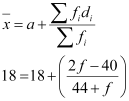
 Hence, the missing frequency, f, is 20.
Hence, the missing frequency, f, is 20.
Q4 : Thirty women were examined in a hospital by a doctor and the number of heart beats per minute were recorded and summarized as follows. Fine the mean heart beats per minute for these women, choosing a suitable method.
| Number of heart beats per minute |
65-68 |
68-71 |
71-74 |
74-77 |
77-80 |
80-83 |
83 – 86 |
| Number of women |
2 |
4 |
3 |
8 |
7 |
4 |
2 |
Answer :
To find the class mark of each interval (xi), the following relation is used.
![]()
Class size, h, of this data = 3
Taking 75.5 as assumed mean (a), di, ui, fiui are calculated as follows.
|
Number of heart beats per minute |
Number of women fi |
xi |
di =xi-75.5 |
|
fiui |
|
65 – 68 |
2 |
66.5 |
– 9 |
– 3 |
– 6 |
|
68 – 71 |
4 |
69.5 |
– 6 |
– 2 |
– 8 |
|
71 – 74 |
3 |
72.5 |
– 3 |
– 1 |
– 3 |
|
74 – 77 |
8 |
75.5 |
0 |
0 |
0 |
|
77 – 80 |
7 |
78.5 |
3 |
1 |
7 |
|
80 – 83 |
4 |
81.5 |
6 |
2 |
8 |
|
83 – 86 |
2 |
84.5 |
9 |
3 |
6 |
|
Total |
30 |
4 |
From the table, we obtain

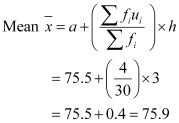
Therefore, mean hear beats per minute for these women are 75.9 beats per minute.
Q5 : In a retail market, fruit vendors were selling mangoes kept in packing boxes. These boxes contained varying number of mangoes. The following was the distribution of mangoes according to the number of boxes.
| Number of mangoes |
50 – 52 |
53 – 55 |
56 – 58 |
59 – 61 |
62 – 64 |
| Number of boxes |
15 |
110 |
135 |
115 |
25 |
Find the mean number of mangoes kept in a packing box. Which method of finding the mean did you choose?
Answer :
|
Number of mangoes |
Number of boxes |
|
50 – 52 |
15 |
|
53 – 55 |
110 |
|
56 – 58 |
135 |
|
59 – 61 |
115 |
|
62 – 64 |
25 |
It can be observed that class intervals are not continuous. There is a gap of 1 between two class intervals. Therefore![]() , has to be added to the upper class limit
, has to be added to the upper class limit ![]() and has to be subtracted from the lower class limit of each interval.
and has to be subtracted from the lower class limit of each interval.
Class mark (xi) can be obtained by using the following relation.
![]()
Class size (h) of this data = 3
Taking 57 as assumed mean (a), di, ui, fiui are calculated as follows.
|
Class interval |
fi |
xi |
di =xi– 57 |
|
fiui |
|
49.5 – 52.5 |
15 |
51 |
– 6 |
– 2 |
– 30 |
|
52.5 – 55.5 |
110 |
54 |
– 3 |
– 1 |
– 110 |
|
55.5 – 58.5 |
135 |
57 |
0 |
0 |
0 |
|
58.5 – 61.5 |
115 |
60 |
3 |
1 |
115 |
|
61.5 – 64.5 |
25 |
63 |
6 |
2 |
50 |
|
Total |
400 |
25 |
It can be observed that
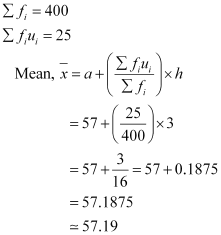
Mean number of mangoes kept in a packing box is 57.19.
Step deviation method is used here as the values of fi, di are big and also, there is a common multiple between all di.
Q6 : The table below shows the daily expenditure on food of 25 households in a locality.
| Daily expenditure (in Rs) |
100-150 |
150 – 200 |
200 – 250 |
250 – 300 |
300 – 350 |
| Number of households |
4 |
5 |
12 |
2 |
2 |
Find the mean daily expenditure on food by a suitable method.
Answer :
To find the class mark (xi) for each interval, the following relation is used.
![]()
Class size = 50
Taking 225 as assumed mean (a), di, ui, fiui are calculated as follows.
|
Daily expenditure (in Rs) |
fi |
xi |
di =xi– 225 |
fiui |
|
|
100 – 150 |
4 |
125 |
– 100 |
– 2 |
– 8 |
|
150 – 200 |
5 |
175 |
– 50 |
– 1 |
– 5 |
|
200 – 250 |
12 |
225 |
0 |
0 |
0 |
|
250 – 300 |
2 |
275 |
50 |
1 |
2 |
|
300 – 350 |
2 |
325 |
100 |
2 |
4 |
|
Total |
25 |
– 7 |
From the table, we obtain
![]()
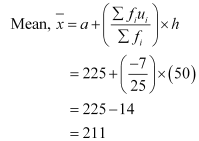
Therefore, mean daily expenditure on food is Rs 211.
Q7 : To find out the concentration of SO2 in the air (in parts per million, i.e., ppm), the data was collected for 30 localities in a certain city and is presented below:
|
concentration of SO2 (in ppm) |
Frequency |
|
0.00 – 0.04 |
4 |
|
0.04 – 0.08 |
9 |
|
0.08 – 0.12 |
9 |
|
0.12 – 0.16 |
2 |
|
0.16 – 0.20 |
4 |
|
0.20 – 0.24 |
2 |
Find the mean concentration of SO2 in the air.
Answer :
To find the class marks for each interval, the following relation is used.
![]()
Class size of this data = 0.04
Taking 0.14 as assumed mean(a), di, ui, fiui are calculated as follows.
|
Concentration of SO2 (in ppm) |
Frequency |
Class mark |
di =xi– 0.14 |
fiui |
|
|
0.00 – 0.04 |
4 |
0.02 |
-0.12 |
– 3 |
-12 |
|
0.04 – 0.08 |
9 |
0.06 |
-0.08 |
– 2 |
-18 |
|
0.08 – 0.12 |
9 |
0.10 |
-0.04 |
– 1 |
– 9 |
|
0.12 – 0.16 |
2 |
0.14 |
0 |
0 |
0 |
|
0.16 – 0.20 |
4 |
0.18 |
0.04 |
1 |
4 |
|
0.20 – 0.24 |
2 |
0.22 |
0.08 |
2 |
4 |
|
Total |
30 |
-31 |
From the table, we obtain
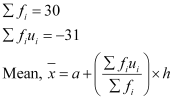
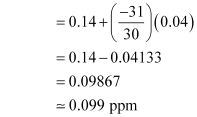
Therefore, mean concentration of SO2 in the air is 0.099 ppm.
Q8 : A class teacher has the following absentee record of 40 students of a class for the whole term. Find the mean number of days a student was absent.
| Number of days |
0-6 |
6 – 10 |
10 – 14 |
14 – 20 |
20 – 28 |
28 – 38 |
38 – 40 |
| Number of students |
11 |
10 |
7 |
4 |
4 |
3 |
1 |
Answer :
To find the class mark of each interval, the following relation is used.
![]()
Taking 17 as assumed mean(a), di, ui, fiui are calculated as follows.
|
Number of days |
Number of students |
xi |
di =xi– 17 |
fidi |
|
0 – 6 |
11 |
3 |
– 14 |
– 154 |
|
6 – 10 |
10 |
8 |
– 9 |
– 90 |
|
10 – 14 |
7 |
12 |
– 5 |
– 35 |
|
14 – 20 |
4 |
17 |
0 |
0 |
|
20 – 28 |
4 |
24 |
7 |
28 |
|
28 – 38 |
3 |
33 |
16 |
48 |
|
38 – 40 |
1 |
39 |
22 |
22 |
|
Total |
40 |
– 181 |
From the table, we obtain

Therefore, the mean number of days is 12.48 days for which a student was absent.
Q9 : The following table gives the literacy rate (in percentage) of 35 cities. Find the mean literacy rate.
| Literacy rate (in %) |
45 – 55 |
55 – 65 |
65 – 75 |
75 – 85 |
85 – 95 |
| Number of cities |
3 |
10 |
11 |
8 |
3 |
Answer :
To find the class marks, the following relation is used.
![]()
Class size (h) for this data = 10
Taking 70 as assumed mean (a), di, ui, fiui and fiui are calculated as follows.
|
Literacy rate (in %) |
Number of cities |
xi |
di =xi– 70 |
fiui |
|
|
45 – 55 |
3 |
50 |
– 20 |
– 2 |
– 6 |
|
55 – 65 |
10 |
60 |
– 10 |
– 1 |
– 10 |
|
65 – 75 |
11 |
70 |
0 |
0 |
0 |
|
75 – 85 |
8 |
80 |
10 |
1 |
8 |
|
85 – 95 |
3 |
90 |
20 |
2 |
6 |
|
Total |
35 |
– 2 |
From the table, we obtain

Therefore, mean literacy rate is 69.43%.
Exercise 14.2 : Solutions of Questions on Page Number : 275
Q1 : The following table shows the ages of the patients admitted in a hospital during a year:
| age (in years) |
5 – 15 |
15 – 25 |
25 – 35 |
35 – 45 |
45 – 55 |
55 – 65 |
| Number of patients |
6 |
11 |
21 |
23 |
14 |
5 |
Find the mode and the mean of the data given above. Compare and interpret the two measures of central tendency.
Answer :
To find the class marks (xi), the following relation is used.
![]()
Taking 30 as assumed mean (a), di and fidiare calculated as follows.
|
Age (in years) |
Number of patients fi |
Class mark xi |
di = |
fidi |
|
5 – 15 |
6 |
10 |
– 20 |
– 120 |
|
15 – 25 |
11 |
20 |
– 10 |
– 110 |
|
25 – 35 |
21 |
30 |
0 |
0 |
|
35 – 45 |
23 |
40 |
10 |
230 |
|
45 – 55 |
14 |
50 |
20 |
280 |
|
55 – 65 |
5 |
60 |
30 |
150 |
|
Total |
80 |
430 |
From the table, we obtain
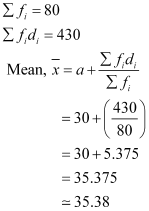
Mean of this data is 35.38. It represents that on an average, the age of a patient admitted to hospital was 35.38 years.
It can be observed that the maximum class frequency is 23 belonging to class interval 35 – 45.
Modal class = 35 – 45
Lower limit (l) of modal class = 35
Frequency (f1) of modal class = 23
Class size (h) = 10
Frequency (f0) of class preceding the modal class = 21
Frequency (f2) of class succeeding the modal class = 14

Mode =
Mode is 36.8. It represents that the age of maximum number of patients admitted in hospital was 36.8 years.
Q2 : The following data gives the information on the observed lifetimes (in hours) of 225 electrical components:
| Lifetimes (in hours) |
0 – 20 |
20 – 40 |
40 – 60 |
60 – 80 |
80 – 100 |
100 – 120 |
| Frequency |
10 |
35 |
52 |
61 |
38 |
29 |
Determine the modal lifetimes of the components.
Answer :
From the data given above, it can be observed that the maximum class frequency is 61, belonging to class interval 60 – 80.
Therefore, modal class = 60 – 80
Lower class limit (l) of modal class = 60
Frequency (f1) of modal class = 61
Frequency (f0) of class preceding the modal class = 52
Frequency (f2) of class succeeding the modal class = 38
Class size (h) = 20
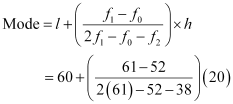
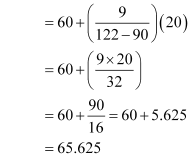
Therefore, modal lifetime of electrical components is 65.625 hours.
Q3 : The following data gives the distribution of total monthly household expenditure of 200 families of a village. Find the modal monthly expenditure of the families. Also, find the mean monthly expenditure.
|
Expenditure (in Rs) |
Number of families |
|
1000 – 1500 |
24 |
|
1500 – 2000 |
40 |
|
2000 – 2500 |
33 |
|
2500 – 3000 |
28 |
|
3000 – 3500 |
30 |
|
3500 – 4000 |
22 |
|
4000 – 4500 |
16 |
|
4500 – 5000 |
7 |
Answer :
It can be observed from the given data that the maximum class frequency is 40, belonging to 1500 – 2000 intervals.
Therefore, modal class = 1500 – 2000
Lower limit (l) of modal class = 1500
Frequency (f1) of modal class = 40
Frequency (f0) of class preceding modal class = 24
Frequency (f2) of class succeeding modal class = 33
Class size (h) = 500


Therefore, modal monthly expenditure was Rs 1847.83.
To find the class mark, the following relation is used.
![]()
Class size (h) of the given data = 500
Taking 2750 as assumed mean ((a), di, ui, fiui are calculated as follows.
|
Expenditure (in Rs) |
Number of families |
xi |
di =xi– 2750 |
fiui |
|
|
1000 – 1500 |
24 |
1250 |
– 1500 |
– 3 |
– 72 |
|
1500 – 2000 |
40 |
1750 |
– 1000 |
– 2 |
– 80 |
|
2000 – 2500 |
33 |
2250 |
– 500 |
– 1 |
– 33 |
|
2500 – 3000 |
28 |
2750 |
0 |
0 |
0 |
|
3000 – 3500 |
30 |
3250 |
500 |
1 |
30 |
|
3500 – 4000 |
22 |
3750 |
1000 |
2 |
44 |
|
4000 – 4500 |
16 |
4250 |
1500 |
3 |
48 |
|
4500 – 5000 |
7 |
4750 |
2000 |
4 |
28 |
|
Total |
200 |
– 35 |
From the table, we obtain
Q4 : The following distribution gives the state-wise teacher-student ratio in higher secondary schools of India. Find the mode and mean of this data. Interpret the two measures.
|
Number of students per teacher |
Number of states/U.T |
|
15 – 20 |
3 |
|
20 – 25 |
8 |
|
25 – 30 |
9 |
|
30 – 35 |
10 |
|
35 – 40 |
3 |
|
40 – 45 |
0 |
|
45 – 50 |
0 |
|
50 – 55 |
2 |
Answer :
It can be observed from the given data that the maximum class frequency is 10 belonging to class interval 30 – 35.
Therefore, modal class = 30 – 35
Class size (h) = 5
Lower limit (l) of modal class = 30
Frequency (f1) of modal class = 10
Frequency (f0) of class preceding modal class = 9
Frequency (f2) of class succeeding modal class = 3
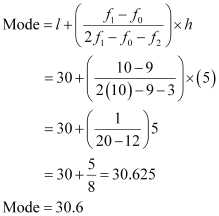
It represents that most of the states/U.T have a teacher-student ratio as 30.6.
To find the class marks, the following relation is used.
![]()
Taking 32.5 as assumed mean (a), di, ui, fiui are calculated as follows.
|
Number of students per teacher |
Number of states/U.T (fi) |
xi |
di =xi-32.5 |
|
fiui |
|
15 – 20 |
3 |
17.5 |
– 15 |
– 3 |
– 9 |
|
20 – 25 |
8 |
22.5 |
– 10 |
– 2 |
– 16 |
|
25 – 30 |
9 |
27.5 |
– 5 |
– 1 |
– 9 |
|
30 – 35 |
10 |
32.5 |
0 |
0 |
0 |
|
35 – 40 |
3 |
37.5 |
5 |
1 |
3 |
|
40 – 45 |
0 |
42.5 |
10 |
2 |
0 |
|
45 – 50 |
0 |
47.5 |
15 |
3 |
0 |
|
50 – 55 |
2 |
52.5 |
20 |
4 |
8 |
|
Total |
35 |
-23 |
Therefore, mean of the data is 29.2.

Therefore, mean of the data is 29.2
It reprasnt that on avrage, teacher-studant ratio was 29.2
Q5 : The given distribution shows the number of runs scored by some top batsmen of the world in one-day international cricket matches.
|
Runs scored |
Number of batsmen |
|
3000 – 4000 |
4 |
|
4000 – 5000 |
18 |
|
5000 – 6000 |
9 |
|
6000 – 7000 |
7 |
|
7000 – 8000 |
6 |
|
8000 – 9000 |
3 |
|
9000 – 10000 |
1 |
|
10000 – 11000 |
1 |
Answer :
From the given data, it can be observed that the maximum class frequency is 18, belonging to class interval 4000 – 5000.
Therefore, modal class = 4000 – 5000
Lower limit (l) of modal class = 4000
Frequency (f1) of modal class = 18
Frequency (f0) of class preceding modal class = 4
Frequency (f2) of class succeeding modal class = 9
Class size (h) = 1000

Therefore, mode of the given data is 4608.7 runs.
Q6 : A student noted the number of cars passing through a spot on a road for 100 periods each of 3 minutes and summarised it in the table given below. Find the mode of the data:
| Number of cars |
0 – 10 |
10 – 20 |
20 – 30 |
30 – 40 |
40 – 50 |
50 – 60 |
60 – 70 |
70 – 80 |
| Frequency |
7 |
14 |
13 |
12 |
20 |
11 |
15 |
8 |
Answer :
From the given data, it can be observed that the maximum class frequency is 20, belonging to 40 – 50 class intervals.
Therefore, modal class = 40 – 50
Lower limit (l) of modal class = 40
Frequency (f1) of modal class = 20
Frequency (f0) of class preceding modal class = 12
Frequency (f2) of class succeeding modal class = 11
Class size = 10

![]()
Therefore, mode of this data is 44.7 cars.
Exercise 14.3 : Solutions of Questions on Page Number : 287
Q1 : The following frequency distribution gives the monthly consumption of electricity of 68 consumers of a locality. Find the median, mean and mode of the data and compare them.
|
Monthly consumption (in units) |
Number of consumers |
|
65 – 85 |
4 |
|
85 – 105 |
5 |
|
105 – 125 |
13 |
|
125 – 145 |
20 |
|
145 – 165 |
14 |
|
165 – 185 |
8 |
|
185 – 205 |
4 |
Answer :
To find the class marks, the following relation is used.
![]()
Taking 135 as assumed mean (a), di, ui, fiui are calculated according to step deviation method as follows.
|
Monthly consumption (in units) |
Number of consumers (fi) |
xi class mark |
di=xi-135 |
|
|
|
65 – 85 |
4 |
75 |
– 60 |
– 3 |
-12 |
|
85 – 105 |
5 |
95 |
– 40 |
– 2 |
-10 |
|
105 – 125 |
13 |
115 |
– 20 |
– 1 |
-13 |
|
125 – 145 |
20 |
135 |
0 |
0 |
0 |
|
145 – 165 |
14 |
155 |
20 |
1 |
14 |
|
165 – 185 |
8 |
175 |
40 |
2 |
16 |
|
185 – 205 |
4 |
195 |
60 |
3 |
12 |
|
Total |
68 |
7 |
From the table, we obtain


From the table, it can be observed that the maximum class frequency is 20, belonging to class interval 125 – 145.
Modal class = 125 – 145
Lower limit (l) of modal class = 125
Class size (h) = 20
Frequency (f1) of modal class = 20
Frequency (f0) of class preceding modal class = 13
Frequency (f2) of class succeeding the modal cla
Q2 : If the median of the distribution is given below is 28.5, find the values of x and y.
|
Class interval |
Frequency |
|
0 – 10 |
5 |
|
10 – 20 |
x |
|
20 – 30 |
20 |
|
30 – 40 |
15 |
|
40 – 50 |
y |
|
50 – 60 |
5 |
|
Total |
60 |
Answer :
The cumulative frequency for the given data is calculated as follows.
|
Class interval |
Frequency |
Cumulative frequency |
|
0 – 10 |
5 |
5 |
|
10 – 20 |
x |
5+ x |
|
20 – 30 |
20 |
25 + x |
|
30 – 40 |
15 |
40 + x |
|
40 – 50 |
y |
40+ x + y |
|
50 – 60 |
5 |
45 + x + y |
|
Total (n) |
60 |
From the table, it can be observed that n = 60
45 + x + y = 60
x + y = 15 (1)
Median of the data is given as 28.5 which lies in interval 20 – 30.
Therefore, median class = 20 – 30
Lower limit (l) of median class = 20
Cumulative frequency (cf) of class preceding the median class = 5 + x
Frequency (f) of median class = 20
Class size (h) = 10
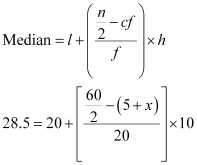

From equation (1),
8 + y = 15
y = 7
Hence, the values of x and y are 8 and 7 respectively.
Q3 : A life insurance agent found the following data for distribution of ages of 100 policy holders. Calculate the median age, if policies are given only to persons having age 18 years onwards but less than 60 year.
|
Age (in years) |
Number of policy holders |
|
Below 20 |
2 |
|
Below 25 |
6 |
|
Below 30 |
24 |
|
Below 35 |
45 |
|
Below 40 |
78 |
|
Below 45 |
89 |
|
Below 50 |
92 |
|
Below 55 |
98 |
|
Below 60 |
100 |
Answer :
Here, class width is not the same. There is no requirement of adjusting the frequencies according to class intervals. The given frequency table is of less than type represented with upper class limits. The policies were given only to persons with age 18 years onwards but less than 60 years. Therefore, class intervals with their respective cumulative frequency can be defined as below.
|
Age (in years) |
Number of policy holders |
Cumulative frequency (cf) |
|
18 – 20 |
2 |
2 |
|
20 – 25 |
6 – 2 = 4 |
6 |
|
25 – 30 |
24 – 6 = 18 |
24 |
|
30 – 35 |
45 – 24 = 21 |
45 |
|
35 – 40 |
78 – 45 = 33 |
78 |
|
40 – 45 |
89 – 78 = 11 |
89 |
|
45 – 50 |
92 – 89 = 3 |
92 |
|
50 – 55 |
98 – 92 = 6 |
98 |
|
55 – 60 |
100 – 98 = 2 |
100 |
|
Total (n) |
From the table, it can be observed that n = 100.
Cumulative frequency (cf) just greater than![]() is 78, belonging to interval 35 – 40.
is 78, belonging to interval 35 – 40.
Therefore, median class = 35 – 40
Lower limit (l) of median class = 35
Class size (h) = 5
Frequency (f) of median class = 33
Cumulative frequency (cf) of class preceding median class = 45

Therefore, median age is 35.76 years.
Q4 : The lengths of 40 leaves of a plant are measured correct to the nearest millimeter, and the data obtained is represented in the following table:
|
Length (in mm) |
Number or leaves fi |
|
118 – 126 |
3 |
|
127 – 135 |
5 |
|
136 – 144 |
9 |
|
145 – 153 |
12 |
|
154 – 162 |
5 |
|
163 – 171 |
4 |
|
172 – 180 |
2 |
Find the median length of the leaves.
(Hint: The data needs to be converted to continuous classes for finding the median, since the formula assumes continuous classes. The classes then change to 117.5 – 126.5, 126.5 – 135.5… 171.5 – 180.5)
Answer :
The given data does not have continuous class intervals. It can be observed that the difference between two class intervals is 1. Therefore![]() , has to be added and subtracted to upper class limits and lower class limits respectively.
, has to be added and subtracted to upper class limits and lower class limits respectively.
Continuous class intervals with respective cumulative frequencies can be represented as follows.
|
Length (in mm) |
Number or leaves fi |
Cumulative frequency |
|
117.5 – 126.5 |
3 |
3 |
|
126.5 – 135.5 |
5 |
3 + 5 = 8 |
|
135.5 – 144.5 |
9 |
8 + 9 = 17 |
|
144.5 – 153.5 |
12 |
17 + 12 = 29 |
|
153.5 – 162.5 |
5 |
29 + 5 = 34 |
|
162.5 – 171.5 |
4 |
34 + 4 = 38 |
|
171.5 – 180.5 |
2 |
38 + 2 = 40 |
From the table, it can be observed that the cumulative frequency just greater than![]() is 29, belonging to class interval 144.5 – 153.5.
is 29, belonging to class interval 144.5 – 153.5.
Median class = 144.5 – 153.5
Lower limit (l) of median class = 144.5
Class size (h) = 9
Frequency (f) of median class = 12
Cumulative frequency (cf) of class preceding median class = 17
Median

Therefore, median length of leaves is 146.75 mm.
Q5 : Find the following table gives the distribution of the life time of 400 neon lamps:
|
Life time (in hours) |
Number of lamps |
|
1500 – 2000 |
14 |
|
2000 – 2500 |
56 |
|
2500 – 3000 |
60 |
|
3000 – 3500 |
86 |
|
3500 – 4000 |
74 |
|
4000 – 4500 |
62 |
|
4500 – 5000 |
48 |
Find the median life time of a lamp.
Answer :
The cumulative frequencies with their respective class intervals are as follows.
|
Life time |
Number of lamps (fi) |
Cumulative frequency |
|
1500 – 2000 |
14 |
14 |
|
2000 – 2500 |
56 |
14 + 56 = 70 |
|
2500 – 3000 |
60 |
70 + 60 = 130 |
|
3000 – 3500 |
86 |
130 + 86 = 216 |
|
3500 – 4000 |
74 |
216 + 74 = 290 |
|
4000 – 4500 |
62 |
290 + 62 = 352 |
|
4500 – 5000 |
48 |
352 + 48 = 400 |
|
Total (n) |
400 |
It can be observed that the cumulative frequency just greater than ![]() is 216, belonging to class interval 3000 – 3500.
is 216, belonging to class interval 3000 – 3500.
Median class = 3000 – 3500
Lower limit (l) of median class = 3000
Frequency (f) of median class = 86
Cumulative frequency (cf) of class preceding median class = 130
Class size (h) = 500
Median
 = 3406.976
= 3406.976
Therefore, median life time of lamps is 3406.98 hours.
Q6 : 100 surnames were randomly picked up from a local telephone directory and the frequency distribution of the number of letters in the English alphabets in the surnames was obtained as follows:
|
Number of letters |
1 – 4 |
4 – 7 |
7 – 10 |
10 – 13 |
13 – 16 |
16 – 19 |
|
Number of surnames |
6 |
30 |
40 |
6 |
4 |
4 |
Determine the median number of letters in the surnames. Find the mean number of letters in the surnames? Also, find the modal size of the surnames.
Answer :
The cumulative frequencies with their respective class intervals are as follows.
|
Number of letters |
Frequency (fi) |
Cumulative frequency |
|
1 – 4 |
6 |
6 |
|
4 – 7 |
30 |
30 + 6 = 36 |
|
7 – 10 |
40 |
36 + 40 = 76 |
|
10 – 13 |
16 |
76 + 16 = 92 |
|
13 – 16 |
4 |
92 + 4 = 96 |
|
16 – 19 |
4 |
96 + 4 = 100 |
|
Total (n) |
100 |
It can be observed that the cumulative frequency just greater than![]() is 76, belonging to class interval 7 – 10.
is 76, belonging to class interval 7 – 10.
Median class = 7 – 10
Lower limit (l) of median class = 7
Cumulative frequency (cf) of class preceding median class = 36
Frequency (f) of median class = 40
Class size (h) = 3
Median

= 8.05
To find the class marks of the given class intervals, the following relation is used.
![]()
Taking 11.5 as assumed mean (a), di, ui, fiui are calculated according to step deviation method as follows.
|
Number of letters |
Number of surnames |
xi |
di =xi -11.5 |
fiui |
|
|
1 – 4 |
6 |
2.5 |
– 9 |
– 3 |
– 18 |
|
4 – 7 |
30 |
5.5 |
– 6 |
– 2 |
– 60 |
|
7 – 10 |
40 |
8.5 |
– 3 |
– 1 |
– 40 |
|
16 |
11.5 |
0 |
0 |
0 |
|
|
13-16 |
4 |
14.5 |
3 |
1 |
4 |
|
16-19 |
4 |
17.5 |
6 |
2 |
8 |
|
Total |
100 |
-106 |
from the table, we obtain
∑fµi=-106
∑fi=100

Q7 : The distribution below gives the weights of 30 students of a class. Find the median weight of the students.
|
Weight (in kg) |
40 – 45 |
45 – 50 |
50 – 55 |
55 – 60 |
60 – 65 |
65 – 70 |
70 – 75 |
|
Number of students |
2 |
3 |
8 |
6 |
6 |
3 |
2 |
Answer :
The cumulative frequencies with their respective class intervals are as follows.
|
Weight (in kg) |
Frequency (fi) |
Cumulative frequency |
|
40 – 45 |
2 |
2 |
|
45 – 50 |
3 |
2 + 3 = 5 |
|
50 – 55 |
8 |
5 + 8 = 13 |
|
55 – 60 |
6 |
13 + 6 = 19 |
|
60 – 65 |
6 |
19 + 6 = 25 |
|
65 – 70 |
3 |
25 + 3 = 28 |
|
70 – 75 |
2 |
28 + 2 = 30 |
|
Total (n) |
30 |
Cumulative frequency just greater than![]() is 19, belonging to class interval 55 – 60.
is 19, belonging to class interval 55 – 60.
Median class = 55 – 60
Lower limit (l) of median class = 55
Frequency (f) of median class = 6
Cumulative frequency (cf) of median class = 13
Class size (h) = 5
Median

= 56.67
Therefore, median weight is 56.67 kg.
Exercise 14.4 : Solutions of Questions on Page Number : 293
Q1 : The following distribution gives the daily income of 50 workers of a factory.
| Daily income (in Rs) |
100 – 120 |
120 – 140 |
140 – 160 |
160 – 180 |
180 – 200 |
| Number of workers |
12 |
14 |
8 |
6 |
10 |
Convert the distribution above to a less than type cumulative frequency distribution, and draw its give.
Answer :
The frequency distribution table of less than type is as follows.
|
Daily income (in Rs) (upper class limits) |
Cumulative frequency |
|
Less than 120 |
12 |
|
Less than 140 |
12 + 14 = 26 |
|
Less than 160 |
26 + 8 = 34 |
|
Less than 180 |
34 + 6 = 40 |
|
Less than 200 |
40 + 10 = 50 |
Taking upper class limits of class intervals on x-axis and their respective frequencies on y-axis, its ogive can be drawn as follows.
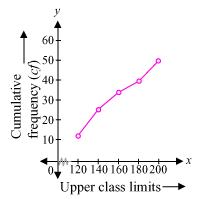
Q2 : During the medical check-up of 35 students of a class, their weights were recorded as follows:
|
Weight (in kg) |
Number of students |
|
Less than 38 |
0 |
|
Less than 40 |
3 |
|
Less than 42 |
5 |
|
Less than 44 |
9 |
|
Less than 46 |
14 |
|
Less than 48 |
28 |
|
Less than 50 |
32 |
|
Less than 52 |
35 |
Draw a less than type ogive for the given data. Hence obtain the median weight from the graph verify the result by using the formula.
Answer :
The given cumulative frequency distributions of less than type are
|
Weight (in kg) upper class limits |
Number of students (cumulative frequency) |
|
Less than 38 |
0 |
|
Less than 40 |
3 |
|
Less than 42 |
5 |
|
Less than 44 |
9 |
|
Less than 46 |
14 |
|
Less than 48 |
28 |
|
Less than 50 |
32 |
|
Less than 52 |
35 |
Taking upper class limits on x-axis and their respective cumulative frequencies on y-axis, its ogive can be drawn as follows.
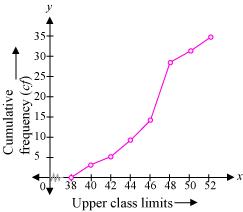
Here, n = 35
So, ![]() = 17.5
= 17.5
Mark the point A whose ordinate is 17.5 and its x-coordinate is 46.5. Therefore, median of this data is 46.5.
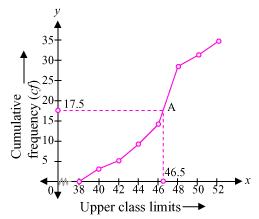
It can be observed that the difference between two consecutive upper class limits is 2. The class marks with their respective frequencies are obtained as below.
|
Weight (in kg) |
Frequency (f) |
Cumulative frequency |
|
Less than 38 |
0 |
0 |
|
38 – 40 |
3 – 0 = 3 |
3 |
|
40 – 42 |
5 – 3 = 2 |
5 |
|
42 – 44 |
9 – 5 = 4 |
9 |
|
44 – 46 |
14 – 9 = 5 |
14 |
|
46 – 48 |
28 – 14 = 14 |
28 |
|
48 – 50 |
32 – 28 = 4 |
32 |
|
50 – 52 |
35 – 32 = 3 |
35 |
|
Total (n) |
35 |
The cumulative frequency just greater than![]() is 28, belonging to class interval 46 – 48.
is 28, belonging to class interval 46 – 48.
Median class = 46 – 48
Lower class limit (l) of median class = 46
Frequency (f) of median class = 14
Cumulative frequency (cf) of class preceding median class = 14
Class size (h) = 2
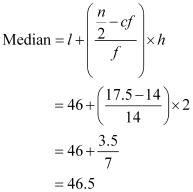
Q3 : The following table gives production yield per hectare of wheat of 100 farms of a village.
| Production yield (in kg/ha) |
50 – 55 |
55 – 60 |
60 – 65 |
65 – 70 |
70 – 75 |
75 – 80 |
| Number of farms |
2 |
8 |
12 |
24 |
38 |
16 |
Change the distribution to a more than type distribution and draw ogive.
Answer :
The cumulative frequency distribution of more than type can be obtained as follows.
|
Production yield (lower class limits) |
Cumulative frequency |
|
more than or equal to 50 |
100 |
|
more than or equal to 55 |
100 – 2 = 98 |
|
more than or equal to 60 |
98 – 8 = 90 |
|
more than or equal to 65 |
90 – 12 = 78 |
|
more than or equal to 70 |
78 – 24 = 54 |
|
more than or equal to 75 |
54 – 38 = 16 |
Taking the lower class limits on x-axis and their respective cumulative frequencies on y-axis, its ogive can be obtained as follows.
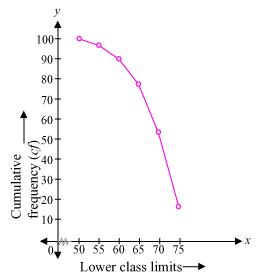
NCERT Solutions for Class 10 Maths All Chapters
- Chapter 1 – Real Numbers
- Chapter 2 – Polynomials
- Chapter 3 – Pair of Linear Equations in Two Variables
- Chapter 4 – Quadratic Equations
- Chapter 5 – Arithmetic Progressions
- Chapter 6 – Triangles
- Chapter 7 – Coordinate Geometry
- Chapter 8 – Introduction to Trigonometry
- Chapter 9 – Some Applications of Trigonometry
- Chapter 10 – Circles
- Chapter 11 – Constructions
- Chapter 12 – Areas Related to Circles
- Chapter 13 – Surface Areas and Volumes
- Chapter 14 – Statistics
- Chapter 15 – Probability